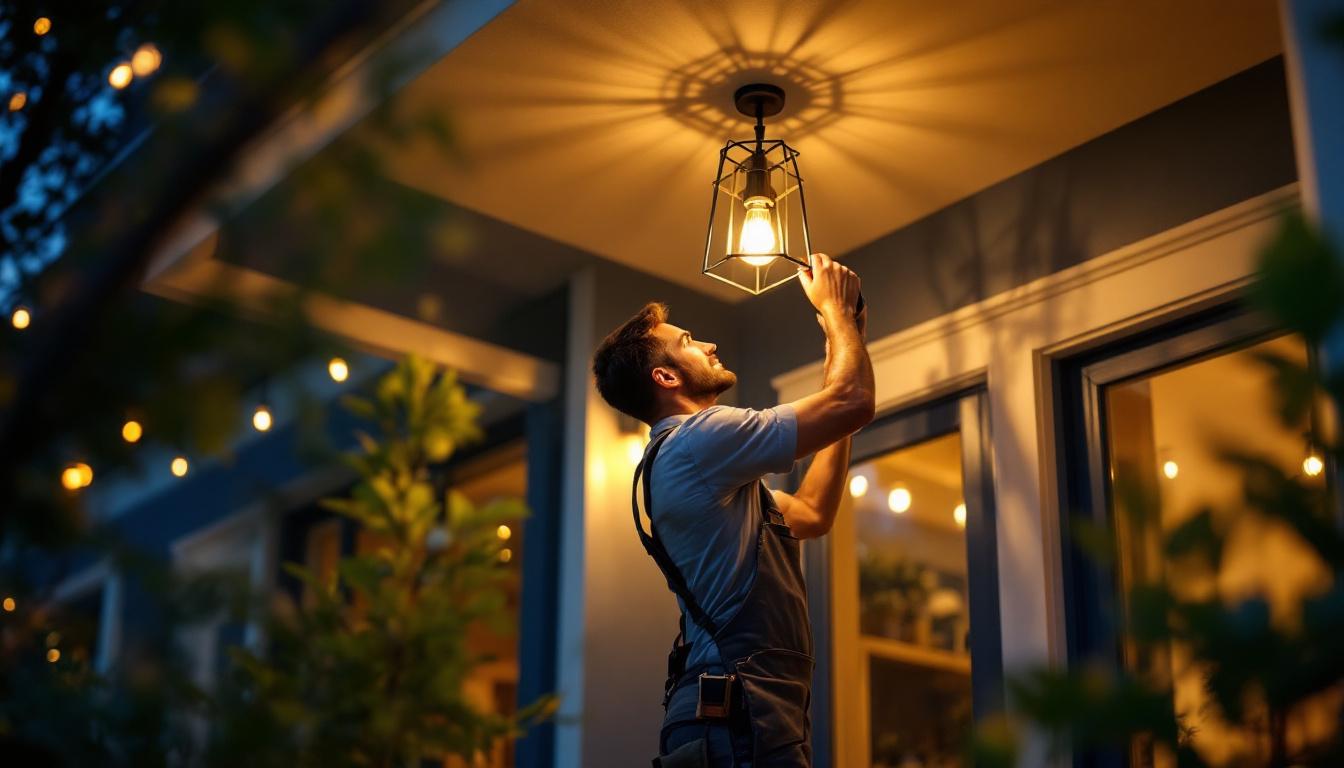
In the ever-evolving world of lighting technology, occupancy sensors have emerged as a significant innovation for enhancing energy efficiency and user convenience. However, for lighting contractors, integrating these devices into projects can present various challenges. This article explores the common obstacles faced by lighting contractors when working with occupancy sensors and offers practical solutions to overcome them.
Occupancy sensors are devices designed to detect the presence of people in a space and automatically control lighting accordingly. By turning lights on when a room is occupied and off when it is empty, these sensors contribute to energy savings and improved user experience. However, their implementation requires a thorough understanding of the technology and its applications.
There are several types of occupancy sensors available on the market, each with unique features and applications. The most common types include passive infrared (PIR), ultrasonic, and dual-technology sensors. Understanding the differences between these technologies is crucial for contractors to select the right sensor for each project.
PIR sensors detect motion based on changes in infrared radiation, making them ideal for areas with predictable movement patterns. Ultrasonic sensors, on the other hand, use sound waves to detect presence, allowing them to cover larger areas and detect motion behind obstacles. Dual-technology sensors combine both PIR and ultrasonic technologies, providing enhanced reliability in various environments.
Integrating occupancy sensors into lighting systems offers numerous benefits. Primarily, they lead to significant energy savings by reducing unnecessary lighting usage. This not only lowers electricity bills but also contributes to environmental sustainability. Additionally, occupancy sensors improve the overall convenience and comfort of spaces by ensuring that lighting is available when needed.
Moreover, these sensors can enhance safety in commercial and residential settings by ensuring that areas are well-lit when occupied, reducing the risk of accidents. For contractors, promoting these advantages can help in convincing clients to adopt occupancy sensor technology.
In addition to energy efficiency and safety, occupancy sensors can also play a pivotal role in smart building technology. As part of an integrated building management system, these sensors can provide valuable data on occupancy patterns, enabling facility managers to optimize space utilization and make informed decisions about future renovations or expansions. This data can lead to more tailored environments that cater to the specific needs of users, enhancing overall satisfaction and productivity.
Furthermore, the advancement of wireless technology has made it easier to install and manage occupancy sensors. Many modern sensors can communicate with other smart devices, allowing for seamless integration into existing systems. This interoperability not only simplifies installation but also enhances the functionality of the entire lighting system, enabling features such as remote monitoring and control via smartphones or tablets. As the demand for energy-efficient solutions continues to rise, the adoption of occupancy sensors is likely to become even more prevalent in both residential and commercial applications.
While the benefits of occupancy sensors are clear, lighting contractors often encounter several challenges during installation and integration. These challenges can range from technical issues to client education and acceptance. Understanding these challenges is the first step towards finding effective solutions.
One of the most significant challenges contractors face is the technical integration of occupancy sensors into existing lighting systems. Compatibility issues may arise, particularly in older buildings with outdated electrical systems. Ensuring that the sensors can communicate effectively with the lighting controls is crucial for optimal performance.
Additionally, the placement of sensors is critical. Improper positioning can lead to false triggers or failure to detect occupancy altogether. Contractors must carefully assess the layout of each space to determine the best locations for sensor installation, taking into account factors such as furniture placement and potential obstructions. This often requires a detailed walkthrough of the space, where contractors must visualize how the sensors will interact with the environment and make adjustments as necessary to avoid common pitfalls.
Moreover, the integration process may also involve software configuration and calibration, which can be daunting for those unfamiliar with the technology. Contractors may need to invest time in training or seek assistance from manufacturers to ensure that the systems are set up correctly and are functioning as intended. This added layer of complexity can lead to delays in project timelines and increased costs, making it essential for contractors to be well-versed in the latest technologies and installation practices.
Another challenge is educating clients about the benefits and functionality of occupancy sensors. Many clients may be hesitant to adopt new technologies due to misconceptions or a lack of understanding. Contractors must be prepared to explain how these sensors work, their advantages, and how they can enhance the overall lighting experience.
Demonstrating the long-term cost savings and environmental benefits can help sway client opinions. Providing case studies or testimonials from previous projects can also serve as persuasive tools in gaining client acceptance. Additionally, contractors can offer demonstrations or pilot installations to showcase the effectiveness of occupancy sensors in real-time, allowing clients to experience the technology firsthand. This hands-on approach not only builds trust but also empowers clients to make informed decisions about their lighting systems.
Furthermore, addressing concerns about privacy and security is crucial, especially in commercial settings where surveillance may be a worry. Contractors should be equipped to discuss how modern occupancy sensors are designed with user privacy in mind, often utilizing advanced technology that respects personal space while still providing the necessary functionality. By fostering open communication and transparency, contractors can alleviate fears and encourage a more positive reception of these innovative lighting solutions.
To successfully navigate the challenges associated with occupancy sensors, lighting contractors can employ various strategies. These approaches not only streamline the installation process but also enhance client satisfaction and project outcomes.
Before beginning any project, conducting a thorough assessment of the space is essential. This includes evaluating the existing lighting system, understanding the layout, and identifying potential obstacles that could affect sensor performance. By gathering this information upfront, contractors can make informed decisions about the type and placement of sensors.
Additionally, involving clients in the assessment process can foster collaboration and ensure that their specific needs and preferences are taken into account. This can lead to a more tailored solution that meets both functional and aesthetic requirements.
Once the installation is complete, providing comprehensive training for clients on how to use and maintain occupancy sensors is vital. Many clients may not be familiar with the technology, and proper training can alleviate concerns and enhance user experience. This training should cover sensor functionality, troubleshooting common issues, and tips for optimizing performance.
Offering ongoing support after installation can also help build trust and strengthen client relationships. Being available to address questions or concerns demonstrates a commitment to customer satisfaction and can lead to repeat business and referrals.
The lighting industry is constantly evolving, with new technologies and best practices emerging regularly. Lighting contractors must stay informed about the latest trends in occupancy sensor technology and lighting controls. Attending industry conferences, participating in training sessions, and engaging with professional organizations can provide valuable insights and keep contractors competitive.
Furthermore, understanding advancements in smart lighting and integration with building management systems can open up new opportunities for contractors. By offering cutting-edge solutions, contractors can differentiate themselves in a crowded market.
Examining successful implementations of occupancy sensors can provide valuable insights and inspiration for lighting contractors. These case studies highlight how various challenges were addressed and the positive outcomes achieved.
In a recent project involving a large commercial office building, the contractor faced challenges related to integrating occupancy sensors into an existing lighting system. The building had a mix of older fluorescent fixtures and newer LED technology, making compatibility a concern.
To overcome this, the contractor conducted a comprehensive assessment of the lighting infrastructure and selected dual-technology sensors that could work effectively with both types of fixtures. After installation, the sensors were programmed to adjust lighting levels based on occupancy patterns, resulting in a 30% reduction in energy consumption. The client was thrilled with the results and praised the contractor for their innovative approach.
Another successful implementation took place in a university setting, where occupancy sensors were installed in classrooms and common areas. The contractor faced initial resistance from faculty members who were concerned about the reliability of the sensors.
To address these concerns, the contractor organized a demonstration showcasing the sensors’ capabilities and benefits. They also provided training for faculty and staff on how to use the sensors effectively. As a result, the university reported increased energy savings and improved user satisfaction, leading to further projects in other buildings on campus.
As technology continues to advance, the future of occupancy sensors looks promising. Emerging trends are set to enhance their functionality and integration into smart building systems.
The integration of occupancy sensors with smart building systems is one of the most significant trends on the horizon. As buildings become more interconnected, occupancy sensors can work in tandem with other smart technologies, such as HVAC systems and security controls, to optimize energy efficiency and enhance user comfort.
This integration allows for real-time data collection and analysis, enabling building managers to make informed decisions about energy usage and occupancy patterns. For lighting contractors, understanding how to implement these integrated systems will be essential for staying competitive in the market.
Advancements in sensor technology are also paving the way for more accurate and reliable occupancy detection. Innovations such as machine learning algorithms and advanced data analytics are being integrated into sensor systems, allowing for adaptive learning based on occupancy patterns over time.
These advancements will enable sensors to become even more efficient, reducing false triggers and enhancing user experience. Contractors who stay abreast of these developments will be well-positioned to offer cutting-edge solutions to their clients.
Lighting occupancy sensors present a wealth of opportunities for lighting contractors, but they also come with their share of challenges. By understanding the technology, addressing common obstacles, and employing effective strategies, contractors can successfully integrate these devices into their projects.
As the industry continues to evolve, staying informed about trends and advancements will be crucial for contractors looking to remain competitive. By embracing the potential of occupancy sensors, lighting contractors can enhance energy efficiency, improve user satisfaction, and contribute to a more sustainable future.
Ready to elevate your lighting projects with the latest occupancy sensor technology? Look no further than LumenWholesale for all your lighting needs. We provide contractors with high-quality, specification-grade lighting products at unbeatable wholesale prices, ensuring you have access to the best value in the market. Our extensive selection is designed to meet the highest industry standards, offering you reliable and high-performance lighting solutions for every project. Plus, with free shipping on bulk orders, you can enjoy premium lighting without hidden fees or compromises. Enhance your energy efficiency and user satisfaction with the perfect blend of quality, affordability, and convenience at LumenWholesale.

Discover the pivotal role exterior ceiling lamps play in the toolkit of lighting contractors.

Discover how solar-powered outdoor light fixtures can revolutionize your business strategy and help you secure more lighting contracts.

Discover the essentials of solar path lighting compliance with our comprehensive guide tailored for lighting contractors.

Discover the essential insights lighting contractors need to know about 8-inch retrofit LED downlights.